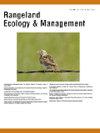Evaluating Native Plant Community Characteristics After Restoration Efforts in Invaded Tallgrass Prairies
IF 2.4
3区 环境科学与生态学
Q2 ECOLOGY
引用次数: 0
Abstract
Invasive grasses reduce native plant diversity in North America's tallgrass prairies and are commonly controlled using herbicide followed by seeding of native plants. Despite the long-term development of plant communities after seeding, evaluations of restoration outcomes rarely exceed 2 yr. Further, plant community development may be influenced by grazing by domestic cattle, a dominant land use in working landscapes that typify the Great Plains, yet this relationship is seldom explored. In the eastern Great Plains, we evaluated plant community characteristics over 8 yr in tallgrass prairies invaded by tall fescue (Schedonorus arundinaceus) after treatment with herbicide followed by seeding native plants. We compared 16 restoration sites seeded once between spring 2014 and 2021 to 2 unrestored, invaded sites and 3 high-diversity reference sites that were not restored. Domestic cattle grazed six restoration sites and one unrestored, invaded site; the remaining sites were ungrazed. In July 2021, we quantified the dominance and cover of herbaceous plants and the composition and richness of seeded species. Annual forb dominance, seeded species establishment and composition, native forb cover, and seeded species richness of older restorations closely resembled references. However, grazed restorations resembled high-quality references less closely than ungrazed restorations. Future studies should consider identifying high-quality reference sites that are grazed because ungrazed references may represent inappropriate target conditions for grazed restorations. The similarities we observed between older restorations and references highlight the importance of long-term evaluations when quantifying restoration outcomes and indicate that treatment with herbicide followed by native seeding has long-lasting positive effects for restoring native plant communities in invaded tallgrass prairies. Enhancing the practicality and effectiveness of restoration efforts in working landscapes is key to supporting grassland restoration.
入侵高草草原恢复后乡土植物群落特征评价
入侵草减少了北美高草草原的本土植物多样性,通常使用除草剂和本土植物播种进行控制。尽管植物群落在播种后会长期发展,但对恢复结果的评估很少超过2年。此外,植物群落的发展可能受到家畜放牧的影响,这是大平原典型工作景观中主要的土地利用方式,但这种关系很少被探讨。在大平原东部,对高羊茅(Schedonorus arundinaceus)入侵的高草草原进行了8年的植物群落特征评价。我们将2014年春季至2021年春季期间播种过一次的16个恢复点与2个未恢复的入侵点和3个未恢复的高多样性参考点进行了比较。家牛放牧了6个恢复点和1个未恢复的入侵点;其余的地点都没有放牧。在2021年7月,我们量化了草本植物的优势度和覆盖度以及种子物种的组成和丰富度。年际牧草优势度、种子种类的建立和组成、原生牧草盖度和种子物种丰富度与文献相似。然而,放牧恢复与未放牧恢复相比,与高质量参考文献的相似程度较低。未来的研究应考虑确定放牧的高质量参考点,因为未放牧的参考点可能不适合放牧恢复的目标条件。我们观察到的旧修复与文献之间的相似性突出了量化恢复结果时长期评估的重要性,并表明除草剂处理后本地播种对恢复入侵高草草原的本地植物群落具有持久的积极作用。提高工作景观恢复工作的实用性和有效性是支持草地恢复的关键。
本文章由计算机程序翻译,如有差异,请以英文原文为准。
求助全文
约1分钟内获得全文
求助全文
来源期刊

Rangeland Ecology & Management
农林科学-环境科学
CiteScore
4.60
自引率
13.00%
发文量
87
审稿时长
12-24 weeks
期刊介绍:
Rangeland Ecology & Management publishes all topics-including ecology, management, socioeconomic and policy-pertaining to global rangelands. The journal''s mission is to inform academics, ecosystem managers and policy makers of science-based information to promote sound rangeland stewardship. Author submissions are published in five manuscript categories: original research papers, high-profile forum topics, concept syntheses, as well as research and technical notes.
Rangelands represent approximately 50% of the Earth''s land area and provision multiple ecosystem services for large human populations. This expansive and diverse land area functions as coupled human-ecological systems. Knowledge of both social and biophysical system components and their interactions represent the foundation for informed rangeland stewardship. Rangeland Ecology & Management uniquely integrates information from multiple system components to address current and pending challenges confronting global rangelands.
 求助内容:
求助内容: 应助结果提醒方式:
应助结果提醒方式:


